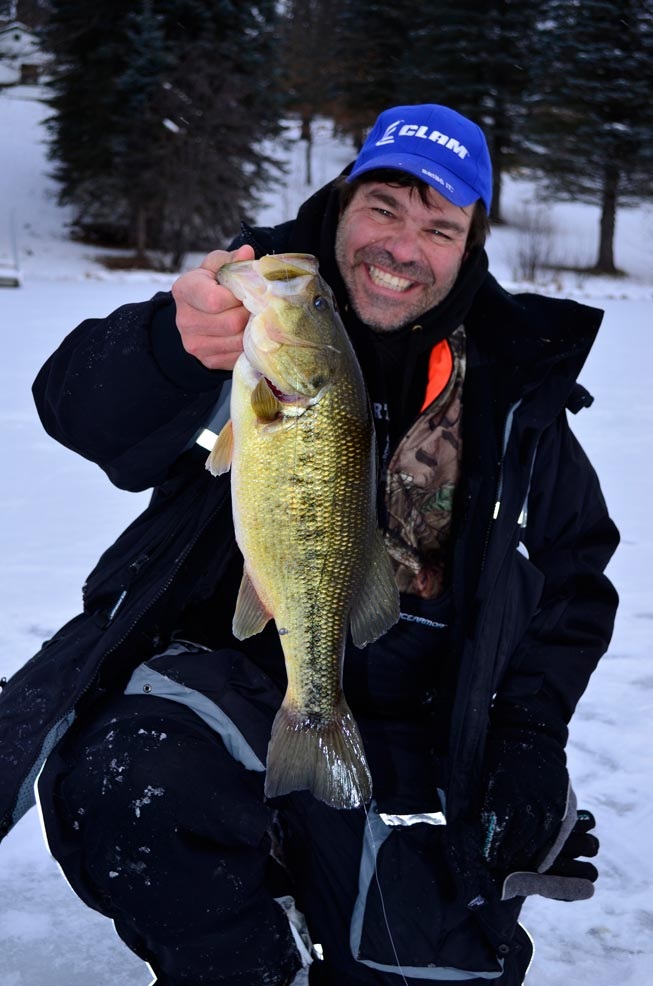 Whether it’s a largemouth, smallmouth, walleye, northern pike, muskie, or another species, it’s amazing how consistently at least one big fish is reeled up through the hole during a day on the ice with Genz and his group. In almost all cases, the outsized fish has a small hook firmly embedded, and the battle takes quite a while on a ‘panfish’ rod.
Whether it’s a largemouth, smallmouth, walleye, northern pike, muskie, or another species, it’s amazing how consistently at least one big fish is reeled up through the hole during a day on the ice with Genz and his group. In almost all cases, the outsized fish has a small hook firmly embedded, and the battle takes quite a while on a ‘panfish’ rod.
Dave Genz for years thought of these catches as accidents, but recently stopped thinking of them that way. “It happens too much,” he says, “to be an accident.”
We had a lengthy conversation about this during the summer of 2014, and Genz racked his brain recounting countless trips, on which most or all fishing took place during daytime hours – because that’s how the Genz pack rolls – and one big fish after another returned to his memory banks. These big fish are being caught when the sun is up, on small baits we think of as panfish fare. The classic notion among anglers – and it’s not unfounded – is that the best fishing takes place during the magic hours of sunrise and sunset, especially sunset. Any good catches during the midday hours, in the old days, were considered unrepeatable gifts from God.
What if you knew, ahead of time, that it would just be a matter of time before you hook into a fish that challenges the limits of your tackle, potentially the biggest fish of that species you’ve ever caught? This is the real potential Genz and his friends have happily celebrated for many years, and you can, too, if you keep a realistic, smallish, irresistible bait in the water.
Allure of Small Baits
This is far from a scientific statement, but all other things being equal in fishing (which they never are, but anyways), fish seem to show a preference for smaller baits under the ice than they do in open water. The difference is especially glaring when you compare ice fishing to the warm summer months.
This apparent universal truth lends support to Genz’s notion that “small jigs that fish heavy” are the best choice for most ice-fishing situations. Why might that be? Most likely it’s because fish metabolism slows down in cold water, and fish get a better look at what they eat under the ice than at any other time of year. There’s no escaping the truth that ‘small baits’ catch everything, including eye-popping lunkers, especially when those small baits are consistently presented in a natural manner.
Just Lucky?
As random as these big-fish-on-small-bait catches might seem at first glance, there is a formula that makes sense, that can lead you in the right direction.
• Seek out places that produce big sunfish, crappies, and/or perch.
• Fish those areas hard with baits chosen to tempt panfish.
• Happily accept whatever bites come your way, and don’t be surprised if you or someone in your group tangles with a big one.
Call them incidental catches if you want, but where big panfish are, big predators prowl, and the same baits that lure panfish will snag giants. You’re trying to catch a big bluegill, but are you going to complain if a big pike chomps down on your jig and tries to make off with it, or are you going to set the hook and go for the ride of your life?
“Generally speaking,” says Genz, “if a lake produces large panfish, there are large predator fish in those same lakes. In other words, if a lake is full of stunted bluegills, there probably aren’t a bunch of big pike in that lake.”
Landing That Pig
So you set the hook and it feels like you have the bottom of the lake on, only the weight is moving off and shaking its head. It’s one thing to be tight to that fish, and another to get it up on your side of the ice.
If you are using one of the latest ice rods, that performs like a long rod in miniature, it will flex and act as a shock absorber for the line. And speaking of line, if your line is fresh, “it’s amazing how strong 2-pound or 4-pound new line is,” says Genz. “And the drags are so much better on our reels now than they were even a couple years ago. With a good drag, even in the cold, you don’t have to backreel a fish anymore. You just let it take line when it has to.”
Rare will be the fish you can’t tame if you take your time and it doesn’t bury you in weeds or wrap the line around a stump or some other cover. Let the fish fight, keep the line tight, and eventually it will be finning directly under the hole. The trick at this point is to get the big fish’s head started up the hole. They don’t like to have their heads directed into the hole, so they tend to resist. When you’re using light line and a small hook, there’s a limit to how much pressure you can put on the fish without tearing the hook out or breaking the line.
Enter the value of a gaff hook.
If you’re a Boy Scout, you’re packin’ a gaff and can ask somebody get it out of your Fish Trap as you battle the monster. But Genz has made good use of the impromptu gaff he fashions out of a ‘walleye’ rod and treble hook.
“Most of the time,” Genz says, “somebody has a walleye rod along. Just tie on whatever lure you have with the biggest treble. We have some great video of a big pike Steve Pennaz caught on 2-pound-test. I took a walleye rod, tied on a Blade Spoon with a treble hook, wound the bait tight to the rod, and gaffed the fish with it.
“We drilled a second hole, and when the fish’s head came into the hole – that’s all you could see – I reached down and stuck the fish in the jaw with the Blade Spoon and got his head started up and it was over.”
 Note: Dave Genz, known as Mr. Ice Fishing, was the primary driver of the modern ice fishing revolution. He has been enshrined in the National Fresh Water Fishing Hall of Fame and Minnesota Fishing Hall of Fame for his contributions to the sport. For more fishing tips and to order his new info-packed book, Ice Revolution, go to www.davegenz.com.
Note: Dave Genz, known as Mr. Ice Fishing, was the primary driver of the modern ice fishing revolution. He has been enshrined in the National Fresh Water Fishing Hall of Fame and Minnesota Fishing Hall of Fame for his contributions to the sport. For more fishing tips and to order his new info-packed book, Ice Revolution, go to www.davegenz.com.
